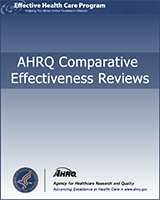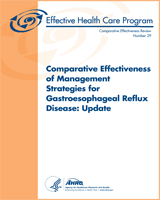NCBI Bookshelf. A service of the National Library of Medicine, National Institutes of Health.
Ip S, Bonis P, Tatsioni A, et al. Comparative Effectiveness of Management Strategies For Gastroesophageal Reflux Disease [Internet]. Rockville (MD): Agency for Healthcare Research and Quality (US); 2005 Dec. (Comparative Effectiveness Reviews, No. 1.)
This publication is provided for historical reference only and the information may be out of date.

Comparative Effectiveness of Management Strategies For Gastroesophageal Reflux Disease [Internet].
Show detailsBackground
Gastroesophageal reflux disease (GERD), defined as weekly heartburn and/or acid regurgitation, is one of the most common health conditions affecting older Americans. Direct costs attributable to GERD were estimated to be $10 billion in the United States in 2000.
Some patients have frequent, severe symptoms requiring long-term regular use of antireflux medications. For these patients, who have chronic GERD, most authorities consider the goals of therapy to be improvement in symptoms and quality of life, healing of and maintenance of healed erosive esophagitis, and prevention of complications (such as Barrett's esophagus, esophageal stricture formation, or esophageal adenocarcinoma). However, there remains considerable uncertainty regarding how these objectives should be achieved.
Among patients treated medically, several approaches are used, depending in part upon the severity of symptoms and clinical response. These include intermittent, periodic, or continuous use of prescription or over-the-counter medications, especially histamine type 2 receptor antagonists (H2RAs) and proton pump inhibitors (PPIs).
The availability of surgery (fundoplication) and, more recently, endoscopic treatments has further complicated management strategies. While surgery has been considered to provide an alternative to permanent use of antisecretory medications, long-term followup of a landmark randomized controlled trial comparing medications with surgery found that approximately two-thirds of surgically treated patients still required regular antireflux medications. Furthermore, while advocates of surgery continue to suggest that it might be more effective than medical therapy for prevention of Barrett's esophagus and esophageal cancer, evidence supporting this assertion has been inconclusive.
A challenge in treating GERD is that neither improvement in symptoms nor reduction in the need for antisecretory medications has consistently correlated with objective measures such as normalization of esophageal pH exposure or healing of esophagitis. The endoscopic approaches, in particular, have drawn into focus the disparities that can exist among various objectives in treating GERD.
This report examines alternatives for managing the chronic symptoms of uncomplicated GERD in patients who may require long-term treatment. It summarizes the available evidence comparing the efficacy and safety of medical, surgical, and endoscopic interventions in the treatment of chronic GERD, particularly after long-term followup. Questions addressed in this report are:
- 1.
What is the evidence of the comparative effectiveness of medical, surgical, and endoscopic treatments for improving objective and subjective outcomes in patients with chronic GERD?
- 2.
Is there evidence that effectiveness of medical, surgical, and endoscopic treatments varies for specific patient subgroups?
- 3.
What are the short- and long-term adverse effects associated with specific medical, surgical, and endoscopic therapies for GERD?
A summary of the findings is shown in Table A.
Table A
Summary of Comparative Data on Treatments of GERD.
Conclusions
Comparison of medical treatments with surgery
- Medical therapy with PPIs and surgery (fundoplication) appeared to be similarly effective for improving symptoms and decreasing esophageal acid exposure. However, only a few studies directly compared these approaches and the total number of patients studied was small.
- In the studies reviewed for this report, from 10 percent to 65 percent of surgical patients still required medications.
- The body of evidence supporting the above conclusion was based on three head-to-head comparative trials. The studies had methodological flaws making them susceptible to some bias, but not sufficient to invalidate the results (Grade B).
- The limited data available did not support a significant benefit of fundoplication compared with medical therapy for preventing Barrett's esophagus or esophageal adenocarcinoma.
Comparison of surgery with endoscopic procedures
- Of the three nonrandomized studies that compared an endoscopic procedure with laparoscopic fundoplication in patients with GERD documented by pH or endoscopy, the longest followup was 8 months, and all three studies had significant bias that may invalidate the results (Grade C).
- Two studies reported that more patients treated with laparoscopic fundoplication were satisfied with their results compared with those who had EndoCinch™. One of these studies and a study of Stretta® also found less need for PPIs in patients who had fundoplication.
Comparison of medical treatments with endoscopic procedures
- There was no head-to-head comparison of medical treatments with endoscopic treatments.
Comparison of medical treatments (between classes and within class)
- PPIs were superior to H2RAs in resolution of GERD symptoms at 4 weeks and healing of esophagitis at 8 weeks.
- The above conclusion was based on three recent meta-analyses of randomized controlled trials comparing one medication to another. These analyses had minimal bias and their results are considered valid (Grade A).
- There was no difference between omeprazole, lansoprazole, pantoprazole, and rabeprazole for relief of symptoms at 8 weeks.
- No significant difference was found in the comparisons of esomeprazole 40 mg with lansoprazole 30 mg or pantoprazole 40 mg for relief of symptoms at 4 weeks. Similarly, there was no difference in the comparison of esomeprazole 20 mg with omeprazole 20 mg in relief of symptoms at 4 weeks. When esomeprazole 40 mg was compared with omeprazole 20 mg, there was a significant difference in favor of esomeprazole for relief of symptoms at 4 weeks.
- For maintenance medical treatment of 6 months to 1 year, PPIs taken at a standard dose (as suggested by the manufacturers' prescribing information) were more effective than those taken at a lower dose (usually one-half of the standard dose) in preventing relapse of symptoms.
Comparison of surgical techniques
- Laparoscopic fundoplication was as effective as open fundoplication for relieving heartburn and regurgitation, improving quality of life, and decreasing use of antisecretory medications. Almost 90 percent of patients who were followed for 5 or more years in both surgical arms reported improvement in symptoms.
- The above conclusion was based on one fair-quality (Grade B) randomized controlled trial and one poor-quality (Grade C) nonrandomized study.
Comparison of endoscopic treatment with sham
- Compared to sham, Stretta™ was more effective in improving symptoms of reflux and improving quality of life at 6 months and was associated with a decrease in the need for antisecretory medications. Improvement of esophageal pH exposure compared with sham could not be demonstrated for Stretta™.
- This one study on Stretta™ versus sham had a small number of patients and short duration of followup (Grade B).
Patient characteristics associated with outcomes of medical, surgical, and endoscopic treatments
- Patients on maintenance antireflux medications may have higher rates of esophagitis if they have any of the following factors: increased severity of esophagitis at baseline (pretreatment), younger age, and moderate to severe regurgitation.
- There is no substantial evidence to support a difference in surgical outcome based on age, preoperative presence or severity of esophagitis, lower esophageal sphincter incompetence, or esophageal body hypomotility.
- Patients treated surgically who have a history of psychiatric disorders may have worse symptom and satisfaction outcomes than those without a significant psychiatric history.
Adverse events associated with medical, surgical, and endoscopic treatments
- The quality of reporting of adverse events and complications was inconsistent across studies. None of the studies used an acceptable standard or scale for defining severity.
- Higher adverse event rates were described for PPIs than for H2RAs or placebo. The most commonly cited events for PPIs and H2RAs were headache, diarrhea, and abdominal pain.
- The most commonly reported complications occurring intraoperatively or within 30 days after open fundoplication were the need for splenectomy, dysphagia, inability to belch, and inability to vomit. The most commonly reported complications for laparoscopic procedures were gastric or esophageal injury or perforation, splenic injury or splenectomy, pneumothorax, bleeding, pneumonia, fever, wound infections, bloating, and dysphagia. Major complications were generally reported at very low rates.
- Frequently reported complications for endoscopic treatments-intraoperatively or within 30 days after the procedure-included chest or retrosternal pain, gastrointestinal injury, bleeding, and short-term dysphagia. The frequency and types of complications varied with the different procedures. Serious complications, including fatalities, have also been described.
Remaining Issues
- More studies are needed to inform how patients with GERD should be managed based upon patient characteristics or response to previous therapy. Additional information is needed to select patients for specific testing for GERD and to determine how treatment should be guided by the results of testing.
- Randomized controlled trials of laparoscopic fundoplication versus PPIs with long-term followup are needed to ascertain the relative benefits and harms of each approach and whether certain subgroups are better served with one or the other alternative.
- Data on comparative endoscopic treatments with continued (or intensified) use of PPIs are needed to better understand their efficacy compared to an established standard.
- More efficacy and safety data on new endoscopic approaches tested against a sham procedure with adequate followup are needed.
To minimize patients' exposure to life-long medications, methods need to be developed to identify patients who do not need long-term antisecretory medications. Long-term studies are needed to assess the risks associated with acid suppression on the development of pneumonia and enteric infections, and to assess the consequences of long-term hypergastrinemia.
- Executive Summary - Comparative Effectiveness of Management Strategies For Gastr...Executive Summary - Comparative Effectiveness of Management Strategies For Gastroesophageal Reflux Disease
Your browsing activity is empty.
Activity recording is turned off.
See more...
